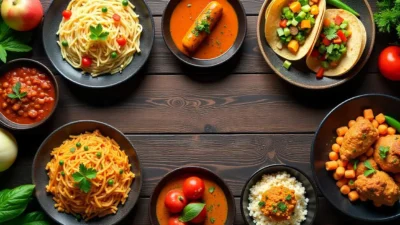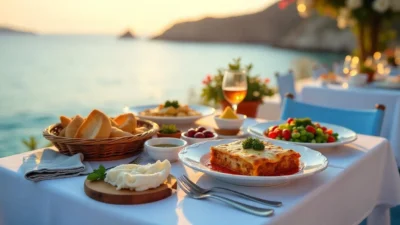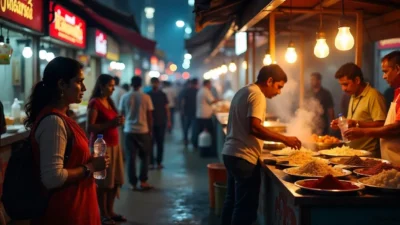Contents
- Easter Traditions, Symbols & Recipes 🌸🥚
- ✝️ The History and Meaning of Easter – A Celebration of Resurrection and Hope 🌅🐣
- 🍽️ The Easter Table: Traditional Dishes That Bring Generations Together 🥚🍞🌿
- 🥚 Pysanky and Easter Eggs – The Magic of Symbols and Color 🎨🌿
- 🌅 Conclusion: Easter Is More Than a Holiday — It’s a State of Heart and Soul 🕊️
Easter Traditions, Symbols & Recipes 🌸🥚
Easter is one of the most beloved and meaningful holidays in many Christian cultures around the world. It’s a celebration rooted in faith, filled with deep symbolism, and surrounded by cherished family traditions. More than just a religious event, Easter represents the triumph of life over death, light over darkness, and hope over despair 🌿🕯️.
This special time of year marks not only the Resurrection of Christ, but also the arrival of spring — a season of renewal, rebirth, and fresh beginnings. Whether celebrated in a grand cathedral or a cozy home, Easter invites people to pause, reflect, and come together with their loved ones in gratitude and joy ❤️.
✝️ A Time of Spiritual Rebirth and Hope
Easter stands at the heart of the Christian calendar as the day that commemorates the Resurrection of Jesus Christ — a powerful symbol of new life and eternal hope. For many, it is the most important and sacred holiday of the year. But Easter is also filled with cultural customs and folk traditions that bring warmth and beauty to the spiritual experience 🌞🌾.
As Easter approaches, preparations begin weeks in advance. Homes are cleaned, food is prepared, eggs are decorated, and special breads are baked. Whether it’s through quiet reflection during Lent, joyful gatherings on Easter Sunday, or the simple act of preparing an Easter basket, each tradition adds to the meaning and magic of the season.
🧺 Traditions That Bring People Together
One of the most beautiful aspects of Easter is its ability to bring generations together. Families gather to decorate eggs, bake holiday treats, and attend church services. These moments of connection — whether large or small — create memories that last a lifetime 🧡.
Across different cultures and regions, Easter is celebrated in diverse ways. From symbolic foods and sacred rituals to local customs and folk crafts, every tradition adds a unique flavor to the holiday. But the core spirit remains the same: love, faith, and the joy of being together.
🥚 The Easter Egg – Symbol of Life and Protection
The egg is one of the most universal and ancient symbols of Easter. It represents life, rebirth, and the miracle of creation. In many cultures, decorated eggs — whether hand-painted, dyed, or carved — are a cherished part of the Easter celebration 🙏✨.
Some eggs are simple and colorful, others are intricate and artistic. In every case, they reflect creativity, heritage, and the desire to bless and protect loved ones. Decorating Easter eggs is not only a fun activity but also a meaningful ritual passed down through generations.
🍞 Easter Bread – Heart of the Holiday Table
Sweet, aromatic Easter bread holds a special place on the holiday table. Whether it’s a tall, soft loaf topped with icing or a braided round filled with raisins and spices, this bread is made with care and intention. Often baked in the days leading up to Easter, it’s a symbol of abundance, generosity, and celebration 🕊️.
Alongside the Easter bread, many homes serve traditional dishes such as hard-boiled eggs, cured meats, horseradish, and cheese. After weeks of fasting, Easter Sunday becomes a joyful feast shared with family and friends.
🌍 A Holiday with Deep Roots and Modern Meaning
Today, Easter continues to evolve while preserving its sacred heart. In cities and rural areas alike, people celebrate in ways that reflect both tradition and modern life. From ancient rituals to creative crafts, from solemn church services to playful egg hunts, Easter offers something meaningful for everyone 💙.
Whether celebrated quietly or with great festivity, Easter reminds us of renewal, kindness, and the beauty of shared human experience.
🔍 What You’ll Find in This Article
In this guide, we’ll explore:
- The history and spiritual meaning of Easter;
- The traditions and customs surrounding the holiday;
- Symbolism of Easter eggs, bread, and baskets;
- Popular Easter foods and how they’re prepared;
- How Easter is celebrated in different parts of the world;
- Modern approaches to keeping traditions alive;
- Easter greetings, fun facts, and more 💡.
🙏 May This Joyful Holiday Bring Light, Peace, and Togetherness
Whether you’re exploring Easter for the first time or honoring traditions from your childhood, this season is an invitation to slow down, reconnect, and find meaning in the simple, beautiful moments 💫.
Christ is Risen! — Indeed He is Risen! 🕊️
✝️ The History and Meaning of Easter – A Celebration of Resurrection and Hope 🌅🐣
Easter is far more than just a date on the calendar. It’s a holiday that has evolved over centuries into a deeply spiritual, cultural, and symbolic celebration across the world. Rooted in faith, enriched by tradition, and closely tied to the rhythms of nature, Easter speaks to the human longing for renewal, light, and hope 💫🌿.
📖 The Origins of Easter – From the Bible to Early Christianity
In Christian belief, Easter commemorates the resurrection of Jesus Christ on the third day after His crucifixion. This event, central to the New Testament, symbolizes the victory of life over death, love over evil, and eternity over the temporary. It lies at the heart of Christian theology — and is the main reason Easter is considered the most sacred holiday of the year ✝️.
The first Easter celebrations date back to the Apostolic Age, when early Christians observed the resurrection during the time of the Jewish Passover. Over time, Easter became a distinct Christian feast, carrying even deeper spiritual significance as it spread through communities of faith.
🌍 The Evolution of Easter Traditions Around the World
As Christianity expanded, Easter customs took on unique forms in different cultures and regions. In Western Europe, traditions like chocolate eggs and Easter bunnies became popular, while in Eastern traditions, you’ll find candlelit midnight services, sacred bread (paska), and intricately painted eggs (pysanky).
Despite differences in practice, the essence remains the same — Easter is a time of joy, gratitude, forgiveness, inner transformation, and light after darkness.
🕯️ The Rich Symbolism of Easter
Easter is filled with meaningful symbols, each representing a deeper truth:
- Light (candles, fire) – a symbol of resurrection, truth, and the triumph of good;
- Egg – representing life, birth, and victory over death;
- Bread (paska) – symbol of spiritual nourishment and the body of Christ;
- Water – cleansing, renewal, and rebirth;
- Springtime – nature’s mirror of spiritual awakening and new beginnings 🌷.
Together, these symbols express a universal theme: the passage from death to life, from winter to spring, from darkness to light.
💬 Easter as a Personal and Spiritual Experience
For many, Easter is more than just rituals or customs — it’s a deeply personal time of reflection. It’s an opportunity to pause, consider one’s spiritual path, clear the mind, offer forgiveness, express gratitude, and renew one’s sense of purpose 🕊️.
Even for those who may not identify as deeply religious, Easter holds a quiet, almost instinctive significance. There’s something pure, heartfelt, and necessary about marking this moment of renewal — a gentle reset for the soul.
📌 Why Easter Still Matters
- Spiritually – It is the cornerstone of Christian faith.
- Culturally – It connects us to our roots and heritage.
- Socially – It brings families and communities together.
- Emotionally – It offers hope in times of uncertainty.
- Seasonally – It aligns with spring and the rebirth of nature.
🌞 Easter Is Not Just a Day on the Calendar — It’s a State of Heart and Mind
The story of Easter is a story of faith, endurance, and the light that never fades — even in the darkest hours. It’s a reminder that rebirth is always possible, that healing can come after pain, and that life always finds a way to bloom again.
And in that message lies Easter’s true power.
🍽️ The Easter Table: Traditional Dishes That Bring Generations Together 🥚🍞🌿
Easter is not only a spiritual celebration — it’s also a heartfelt family tradition, felt in every corner of the home: from the smell of freshly baked Easter bread to the sharp aroma of horseradish that tickles the nose. The Easter table is the heart of the holiday, where loved ones gather after the long Lenten fast to share not only food, but also warmth, gratitude, and the joy of resurrection 💛.
🧺 What Goes Into the Easter Basket?
Before the festive meal begins, the most important foods are traditionally taken to church for blessing, either late at night or early on Easter morning. This ritual holds great spiritual meaning and symbolizes the sanctification of the home and family. A classic Easter basket typically includes:
- Paska – sweet, rich Easter bread symbolizing Christ’s resurrection and the gift of life.
- Easter eggs (krashanky or pysanky) – symbols of new life and rebirth.
- Sausage or ham – representing joy, abundance, and the end of fasting.
- Cheese and butter – signs of purity, peace, and God’s blessing.
- Salt – a protective symbol and sign of purification.
- Horseradish – a reminder of Christ’s suffering and the strength of faith.
Once blessed, these foods carry special meaning and are usually the first to be shared at the Easter table — often in silence and with reverence.
🥖 Paska – The Queen of the Easter Table
No Easter is complete without paska, the golden, aromatic bread baked with prayer and love. Each family often has a treasured recipe passed down through generations. Some bake it with raisins, others with citrus zest or vanilla. Decorations vary from cross-shaped dough ornaments to sugar glaze and colorful sprinkles 🌸
Paska represents Christ as the “Bread of Life,” and is always treated with respect and care — both when baking and serving.
🥚 Eggs – Timeless Symbols of Life
Eggs are among the oldest and most universal symbols of life and rebirth. Decorated Easter eggs — whether simply dyed (krashanky) or intricately hand-painted (pysanky) — are an essential part of the holiday. Traditional colors include red, yellow, green, and blue, each carrying symbolic meaning. Designs like suns, crosses, stars, or trees of life add even more depth 🌞🌱
People exchange eggs, play egg-tapping games, and delight children with colorful baskets full of them.
🍖 Meat, Sausage, and Aspic – A Return to Celebration
After 40 days of fasting, meat dishes return to the table with renewed appreciation. Common Easter dishes include:
- Homemade sausage or oven-roasted ham;
- Aspic (meat jelly) with carrots and herbs;
- Roasted meats with aromatic spices.
These foods symbolize abundance, gratitude, and the joyous end of the Lenten period. Many families prepare them in advance during Holy Week, so they are ready to serve on Easter morning.
🥗 Additional Dishes and Table Decor
In addition to the main staples, the Easter menu may include:
- Fresh green salads;
- Beetroot horseradish — spicy but symbolic;
- Sweet cheese paska – a dessert made from cottage cheese, raisins, and vanilla;
- Honey, fruits, and nuts.
Decor also plays a big role in creating the holiday atmosphere. Easter tables are often adorned with:
- Embroidered linens or tablecloths;
- Candles;
- Spring flowers (tulips, daffodils, periwinkle);
- Hand-decorated eggs and traditional baskets.
Together, these elements create a warm, sacred, and festive ambiance 🕯️🌼
🏡 A Family Tradition Worth Preserving
The Easter table is more than just food. It’s a symbol of unity, family legacy, and continuity. Around it, laughter is shared, prayers are spoken, memories are recalled, and stories are passed on. Children listen, learn, and carry the tradition forward.
🕊️ The Table Where We Don’t Just Eat — We Feel
Each dish carries meaning. Each conversation holds value. That’s why the Easter table is often one of the warmest memories in our hearts. It’s where the spirit of the holiday comes alive — bright, heartfelt, and real.
🥚 Pysanky and Easter Eggs – The Magic of Symbols and Color 🎨🌿
Among all the symbols of Easter, none are as vivid, intricate, and beloved as the decorated eggs — pysanky and krashanky. These beautiful creations adorn baskets, holiday tables, and homes, carrying not only visual charm but also deep spiritual and cultural meaning. A decorated egg is more than an object — it’s a prayer, a blessing, a wish for life, health, and protection. And the tradition of coloring eggs for Easter goes back thousands of years 🌅
🕊️ The Egg as a Symbol of Life and Resurrection
In many cultures, the egg represents birth, beginnings, and the mystery of life. In Christianity, it came to symbolize Christ’s Resurrection — just as life emerges from a seemingly lifeless shell, so too did Christ rise from the tomb, bringing hope and salvation to the world. That’s why the egg became one of Easter’s most enduring and sacred symbols.
🎨 Types of Easter Eggs: Pysanky, Krashanky, and More
In Eastern European tradition, especially in regions with strong Orthodox or folk roots, there are several distinct types of Easter eggs:
- Pysanka – a raw egg decorated using wax-resist techniques and dyes. Each design is filled with symbolic meaning, and the process is meditative and sacred.
- Krashanka – a hard-boiled egg dyed in a single color (commonly red). It symbolizes the blood of Christ, energy, and life.
- Drapanka – a dyed egg with designs scratched into the shell using a sharp tool.
- Malyovanka – an egg painted with a brush using watercolor or tempera paints.
Each region has its own patterns, color schemes, and stories — making these eggs a true expression of folk art and identity 🌾
🌈 Symbolism of Colors and Designs
In the art of pysanky, every detail carries meaning. Nothing is random — every line, spiral, dot, or motif tells a story.
Colors:
- Red – love, joy, life, and the blood of Christ.
- Black – eternity, remembrance, and mystery.
- Yellow – the sun, warmth, and abundance.
- Green – spring, renewal, youth.
- Blue – the sky, purity, spirituality.
- White – innocence, peace, new beginnings.
Designs:
- Sun or stars – source of life and divine light.
- Cross – faith, balance, the four elements or directions.
- Fish – symbol of Christ.
- Tree of life – eternal life and family heritage.
- Flowers, birds, or deer – fertility, beauty, and harmony with nature.
👩🎨 A Tradition Passed From Heart to Heart
Making pysanky is not simply a craft — it’s a sacred ritual. Traditionally, it was done in silence or with prayer, often by candlelight. The egg was seen as a talisman — a powerful symbol that could protect a home, heal illness, or bring prosperity.
This tradition is often passed down from grandmothers to children, connecting generations through shared creativity. And even in today’s fast-paced world, pysanky remain a living tradition ✨
🧒 Easter Eggs with Children – Creative and Meaningful
Today, many families blend ancient customs with modern creativity. Children are encouraged to decorate eggs using paints, markers, stickers, or natural dyes like beet juice, onion skins, or turmeric. It’s not only fun but also deeply educational — children learn about their roots while creating something beautiful with their own hands ❤️
🌿 A Pysanka Is More Than Decoration – It’s a Prayer in Color
Easter eggs are not just a colorful tradition — they are visual prayers, cultural codes, and vessels of meaning. Each pysanka is a story written without words, passed through time and hands, still alive with sacred energy.
And every year, as we sit down to decorate them again, we bring that story back to life.
🌅 Conclusion: Easter Is More Than a Holiday — It’s a State of Heart and Soul 🕊️
Easter is more than just a date on the calendar or a religious event. It’s a moment when the world seems to pause in anticipation of light, and the heart fills with warmth, hope, and faith. It’s a deeply spiritual experience, a celebration of family, and a tribute to ancient traditions that come alive in every gesture, prayer, Easter egg, and slice of paska 🌿🥚🍞
It’s a time of renewal — not only of nature but of ourselves. A reminder that after every darkness, light returns. That faith is not only words, but action, attention, care, and gratitude.
💛 Why Do We Keep Traditions Alive?
Because within them lives our memory. Our culture. Our grandparents, who taught us how to draw our first pysanky. Our children, excited to help with Easter preparations. Traditions are bridges between generations — they connect, heal, and inspire.
By preserving them, we preserve ourselves. And at the same time, we write a new story — one that is honest, heartfelt, and filled with light ✨
🌸 Easter Today Is:
- Heartfelt conversations around the festive table
- A candle’s flame that never fades
- Smiling faces painting Easter eggs
- Prayers whispered from the soul
- Hugs, forgiveness, and new hope
🙏 May This Joyful Holiday Fill Your Home With Peace, Love, and Light
May each egg carry good energy.
May every paska be a blessing.
And may each day after Easter feel just a little brighter, calmer, and kinder 💫
Christ is Risen! — Indeed He is Risen! 🕊️









Beautiful post! Love the focus on both the religious and springtime aspects of Easter.